Initial arch wires used in orthodontic treatment with fixed appliances
- PMID: 38319008
- PMCID: PMC10845215
- DOI: 10.1002/14651858.CD007859.pub5
Initial arch wires used in orthodontic treatment with fixed appliances
Abstract
Background: Initial arch wires are the first arch wires inserted into fixed appliance at the beginning of orthodontic treatment. With a number of different types of orthodontic arch wires available for initial tooth alignment, it is important to understand which are most efficient and which cause the least amount of root resorption and pain during the initial aligning stage of treatment. This is the third update of a Cochrane review first published in 2010.
Objectives: To assess the effects of initial arch wires for the alignment of teeth with fixed orthodontic braces, in terms of the rate of tooth alignment, amount of root resorption accompanying tooth movement, and intensity of pain experienced by patients during the initial alignment stage of treatment.
Search methods: We searched Cochrane Oral Health's Trials Register, CENTRAL, MEDLINE, Embase, and two ongoing trials registries on 4 July 2022.
Selection criteria: We included randomised controlled trials (RCTs) of different initial arch wires used to align teeth with fixed orthodontic braces. We included people with full-arch fixed orthodontic appliances on the upper arch, lower arch, or both arches.
Data collection and analysis: Two independent review authors were responsible for study selection, data extraction, and assessment of risk of bias in included studies. We contacted corresponding authors of included studies to obtain missing information. We resolved disagreements by discussion between the review authors. Our main outcomes were alignment rate (movement of teeth in mm), root resorption, time to alignment, and intensity of pain measured on a 100-mm visual analogue scale (VAS). We pooled data from studies with similar interventions and outcomes using random-effects models. We reported mean differences (MDs) with 95% confidence intervals (CIs) for continuous data, risk ratios (RRs) with 95% CIs for dichotomous data, and alignment rate ratios with 95% CIs for time-to-event data. Two independent review authors assessed the certainty of evidence. We resolved disagreements by discussion between the review authors.
Main results: We included 29 RCTs with 1915 participants (2581 arches) in this review. Studies were generally small (sample sizes ranged from 14 to 200 participants). Duration of follow-up varied between three days and six months. Eleven studies received funding, six received no funding, and 12 provided no information about funding sources. We judged eight studies at high risk of bias, nine at low risk, and 12 at unclear risk. We grouped the studies into six main comparisons. Multistrand stainless steel wires versus wires composed of other materials Six studies with 409 participants (545 arches) evaluated multistrand stainless steel (StSt) wires versus wires composed of other materials. We are very uncertain about the effect of multistrand StSt wires versus other wires on alignment rate (4 studies, 281 participants, 417 arches; very low-certainty evidence). There may be little to no difference between multistrand StSt wires and other wires in terms of intensity of pain (MD -2.68 mm, 95% CI -6.75 to 1.38; 2 studies, 127 participants, 127 arches; low-certainty evidence). Conventional nickel-titanium wires versus superelastic nickel-titanium wires Four studies with 266 participants (274 arches) evaluated conventional nickel-titanium (NiTi) wires versus superelastic NiTi wires. There may be little to no difference between the different wire types in terms of alignment rate (124 participants, 124 arches, 2 studies; low-certainty evidence) and intensity of pain (MD -0.29 mm, 95% CI -1.10 to 0.52; 2 studies, 142 participants, 150 arches; low-certainty evidence). Conventional nickel-titanium wires versus thermoelastic copper-nickel-titanium wires Three studies with 210 participants (210 arches) evaluated conventional Ni-Ti versus thermoelastic copper-nickel-titanium (CuNiTi) wires. We are very uncertain about the effects of the different arch wires on alignment rate (1 study, 66 participants, 66 arches; very low-certainty evidence). There may be little to no difference between conventional NiTi wires and thermoelastic CuNiTi wires in terms of time to alignment (alignment rate ratio 1.30, 95% CI 0.68 to 2.50; 1 study, 60 participants, 60 arches; low-certainty evidence). Superelastic nickel-titanium wires versus thermoelastic nickel-titanium wires Twelve studies with 703 participants (936 arches) evaluated superelastic NiTi versus thermoelastic NiTi wires. There may be little to no difference between superelastic NiTi wires and thermoelastic NiTi wires in alignment rate at four weeks (MD -0.28 mm, 95% CI 0.62 to 0.06; 5 studies, 183 participants, 183 arches; low-certainty evidence). We are very uncertain about the effects of the different wires on root resorption (2 studies, 52 participants, 312 teeth; very low-certainty evidence). Superelastic NiTi wires compared with thermoelastic NiTi wires may result in a slight increase in time to alignment (MD 0.5 months, 95% CI 0.21 to 0.79; 1 study, 32 participants, 32 arches; low-certainty evidence) but are probably associated with a slight increase in intensity of pain (MD 6.96 mm, 95% CI 1.82 to 12.10; 3 studies, 94 participants, 138 arches, moderate-certainty evidence). Single-strand superelastic nickel-titanium wires versus coaxial superelastic nickel-titanium wires Three studies with 104 participants (104 arches) evaluated single-strand superelastic NiTi versus coaxial superelastic NiTi wires. Use of single-strand superelastic NiTi wires compared with coaxial superelastic NiTi wires probably results in a slight reduction in alignment rate at four weeks (MD -2.64 mm, 95% CI -4.61 to -0.67; 2 studies, 64 participants, 64 arches, moderate-certainty evidence). Different sizes of nickel-titanium wires Two studies with 149 participants (232 arches) compared different types of NiTi wires. There may be little to no difference between different sizes of NiTi wires in terms of pain (low-certainty evidence).
Authors' conclusions: Superelastic NiTi wires probably produce slightly more pain after one day than thermoelastic NiTi wires, and single-strand superelastic NiTi wires probably have a lower alignment rate over four weeks compared with coaxial superelastic NiTi wires. All other evidence on alignment rate, root resorption, time to alignment, and pain is of low or very low certainty in all comparisons. Therefore, there is insufficient evidence to determine whether any particular arch wire material or size is superior to any other. The findings of this review are imprecise and unreliable; well-designed larger studies are needed to give better estimates of the benefits and harms of different arch wires. Orthodontists should exercise caution when interpreting the findings of this review and be prepared to adapt their treatment plans based on individual patient needs.
Copyright © 2024 The Cochrane Collaboration. Published by John Wiley & Sons, Ltd.
Conflict of interest statement
CL: none ZW: none FJ: none GTM: none DTM: none WL: none YW: none
Figures
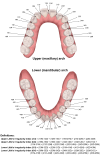


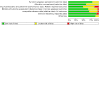
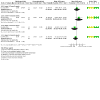
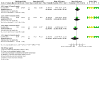
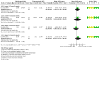
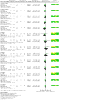


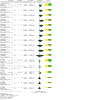
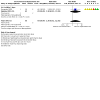




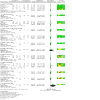

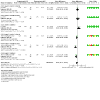


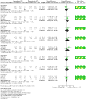

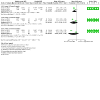


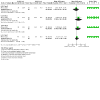

Update of
-
Initial arch wires used in orthodontic treatment with fixed appliances.Cochrane Database Syst Rev. 2018 Jul 31;7(7):CD007859. doi: 10.1002/14651858.CD007859.pub4. Cochrane Database Syst Rev. 2018. Update in: Cochrane Database Syst Rev. 2024 Feb 06;2:CD007859. doi: 10.1002/14651858.CD007859.pub5. PMID: 30064155 Free PMC article. Updated.
References
References to studies included in this review
Alhaija 2021 {published data only}
-
- Alhaija ES, Shahin AY, Badran SA, Daher SO, Daher HO. Pulpal blood flow changes and pain scores related to using superelastic 0.018-inch nickel titanium as the first orthodontic alignment archwire: a prospective clinical trial. Journal of Applied Oral Science 2021;4(29):e20210089. [CENTRAL: CN-02341929] [DOI: 10.1590/1678-7757-2021-0089] [EMBASE: 636316960] [PMID: ] - DOI - PMC - PubMed
-
- NCT04378205. Pulpal blood flow changes using superelastic 0.018-inch nickel titanium. clinicaltrials.gov/show/nct04378205 (first received 2 May 2020). [CENTRAL: CN-02103781]
Atik 2019 {published data only}
-
- Atik E, Gorucu-Coskuner H, Akarsu-Guven B, Taner T. A comparative assessment of clinical efficiency between premium heat-activated copper nickel-titanium and superelastic nickel-titanium archwires during initial orthodontic alignment in adolescents: a randomized clinical trial. Progress in Orthodontics 2019;20:46. [CENTRAL: CN-02012193] [DOI: 10.1186/s40510-019-0299-4] [PMID: ] - DOI - PMC - PubMed
Aydın 2018 {published data only}
-
- Aydın B, Şenışık NE, Koşkan Ö. Evaluation of the alignment efficiency of nickel-titanium and copper-nickel-titanium archwires in patients undergoing orthodontic treatment over a 12-week period: a single-center, randomized controlled clinical trial. Korean Journal of Orthodontics 2018;48(3):153-62. [CENTRAL: CN-02251728] [DOI: 10.4041/kjod.2018.48.3.153] [PMID: ] - DOI - PMC - PubMed
Azizi 2021 {published data only}
-
- IRCT20190705044102N1. Clinical comparison of two Initial arch wires for amount of tooth alignment and perception of pain. trialsearch.who.int/?TrialID=IRCT20190705044102N1 (first received 26 September 2019). [CENTRAL: CN-02069571]
Cioffi 2012 {published data only}
-
- Cioffi I, Piccolo A, Tagliaferri R, Paduano S, Galeotti A, Martina R. Pain perception following first orthodontic archwire placement--thermoelastic vs superelastic alloys: a randomized controlled trial. Quintessence International 2012;43(1):61-9. [CENTRAL: CN-00830922] [PMID: ] - PubMed
Cobb 1998 {published data only}
Erdinç 2004 {published data only}
Evans 1998 {published and unpublished data}
-
- Evans TJ. A clinical comparison and performance perspective of three aligning archwires [MScD dissertation]. Cardiff, UK: University of Wales, 1996. [CENTRAL: CN-01573971]
Fernandes 1998 {published data only}
-
- Fernandes LM, Øgaard B, Skoglund L. Pain and discomfort experienced after placement of a conventional or a superelastic NiTi aligning archwire. A randomized clinical trial [Schmerzen und beschwerden nach eingliederung eines herkömmlichen und eines superelastischen NiTi-nivellierungsbogens]. Journal of Orofacial Orthopedics 1998;59(6):331-9. [CENTRAL: CN-00158092] [DOI: 10.1007/BF01299769] [PMID: ] - DOI - PubMed
Jain 2021 {published data only}
Jones 1992 {published and unpublished data}
-
- Chan LS. Pain and discomfort experienced during orthodontic treatment: a randomised controlled clinical trial of two initial aligning archwires [MScD dissertation]. Cardiff, UK: University of Wales, 1990. [CENTRAL: CN-01573972]
-
- Jones M, Chan C. The pain and discomfort experienced during orthodontic treatment: a randomized controlled clinical trial of two initial aligning arch wires. American Journal of Orthodontics and Dentofacial Orthopedics 1992;102(4):373-81. [CENTRAL: CN-00089169] [DOI: 10.1016/0889-5406(92)70054-e] [PMID: ] - DOI - PubMed
-
- Jones ML, Staniford H, Chan C. Comparison of superelastic NiTi and multistranded stainless steel wires in initial alignment. Journal of Clinical Orthodontics 1990;24(10):611-3. [CENTRAL: CN-01655422] [PMID: ] - PubMed
Joseph 2019 {published data only}
-
- Joseph J, Ninan VS, Abraham ME, John J, Cherian KK, Thomas RM. Arch expansion efficiency of coaxial tubular superelastic nickel-titanium in comparison to single-stranded superelastic nickel-titanium while relieving mandibular anterior crowding: a randomized controlled study. Journal of International Society of Preventive and Community 2019;9(1):60-4. [DOI: 10.4103/jispcd.JISPCD_352_18] [PMID: ] - DOI - PMC - PubMed
Keerthana 2021 {published data only}
Kishore 2019 {published data only}
-
- Kishore S, Saravana Dinesh SP, Srirengalakshmi, Sivakumar A. A randomized clinical trial investigating pain associated with bio-kinetic plus nickel-titanium and conventional nickel-titanium archwires during the initial hours of levelling and aligning the phase of orthodontic treatment. International Journal of Research in Pharmaceutical Sciences 2019;10(2):1321-6. [CENTRAL: CN-01963741] [DOI: 10.26452/ijrps.v10i2.533] - DOI
Mahmoudzadeh 2018 {published data only}
-
- IRCT2016041327362N1. Clinical comparison of two initial archwires for amount of tooth alignment and perception of pain. trialsearch.who.int/?TrialID=IRCT2016041327362N1 (first received 5 June 2016). [CENTRAL: CN-01897969]
-
- Mahmoudzadeh M, Farhadian M, Alijani S, Azizi F. Clinical comparison of two initial arch wires (A-NiTi and heat activated NiTi) for amount of tooth alignment and perception of pain: a randomized clinical trial [Comparaison de deux arcs initiaux (A-NiTi et NiTi thermiques) pour évaluer la quantité d’alignement dentaire et la perception de la douleur: étude clinique randomisée]. International Orthodontics 2018;16(1):60-72. [CENTRAL: CN-01791338] [DOI: 10.1016/j.ortho.2018.01.007] [PMID: ] - DOI - PubMed
Marković 2015 {published and unpublished data}
-
- Marković E, Fercec J, Šćepan I, Glišić B, Nedeljković N, Juloski J, RudolF R. The correlation between pain perception among patients with six different orthodontic archwires and the degree of dental crowding. Srpski Arhiv Za Celokupno Lekarstvo 2015;143(3-4):134-40. [CENTRAL: CN-01102100] [DOI: 10.2298/sarh1504134m] [PMID: ] - DOI - PubMed
-
- Marković ES. Influence of structural properties of orthodontic wires on biocompatibility and pain perception at the beginning of treatment with fixed orthodontic appliances [Doctoral dissertation]. Belgrade, Serbia: University of Belgrade, 2013. [AVAILABLE FROM: https://eteze.bg.ac.rs/application/showtheses?thesesId=1020]
Nabbat 2020 {published data only}
-
- NCT04090931. A clinical comparison of the effectiveness of two types of orthodontic aligning archwire materials. clinicaltrials.gov/show/nct04090931 (first received 9 September 2019). [CENTRAL: CN-01975746]
Nordstrom 2018 {published and unpublished data}
-
- Nordstrom B, Deguchi T, Fields H, Beck FM, Anderson C, Shoji T. Comparison of NiTi and TiNbTaZr archwires in initial orthodontic alignment [Conference Abstract]. In: IADR/AADR/CADR General Session. San Francisco, California, US, 2017:Final Presentation ID 3159. [AVAILABLE FROM: https://iadr.abstractarchives.com/abstract/17iags-2609590/comparison-of-...]
-
- Nordstrom B, Shoji T, Anderson WC, Fields HW Jr, Beck FM, Kim DG, et al. Comparison of changes in irregularity and transverse width with nickel-titanium and niobium-titanium-tantalum-zirconium archwires during initial orthodontic alignment in adolescents: a double-blind randomized clinical trial. Angle Orthodontist 2018;88(3):348-54. [CENTRAL: CN-01913782, CN-01670309] [DOI: 10.2319/061417-393.1] [PMID: ] - DOI - PMC - PubMed
-
- Nordstrom BK. Comparison of NiTi and TiNbTaZr archwires during initial orthodontic alignment [Master thesis]. Columbus, US: The Ohio State University, 2017. [AVAILABLE FROM: http://rave.ohiolink.edu/etdc/view?acc_num=osu1489752104804558]
O'Brien 1990 {published and unpublished data}
-
- O'Brien KD. A randomized controlled clinical trial of aligning archwires. British Journal of Orthodontics 1987;14:315. [CENTRAL: CN-01614442]
-
- Wang Y. Could you help us [personal communication]. Email to: K O'Brien 19 March 2009.
Ong 2011 {published data only}
Pandis 2009 {published data only}
-
- Pandis N, Polychronopoulou A, Eliades T. Alleviation of mandibular anterior crowding with copper-nickel-titanium vs nickel-titanium wires: a double-blind randomized control trial. American Journal of Orthodontics and Dentofacial Orthopedics 2009;136(2):152.e1-.e7; discussion 152-3. [CENTRAL: CN-00704041] [DOI: 10.1016/j.ajodo.2008.08.022] [PMID: ] - DOI - PubMed
Phermsang‐Ngarm 2018 {published data only}
-
- Phermsang-Ngarm P, Charoemratrote C. Tooth and bone changes after initial anterior dental alignment using preformed vs customized nickel titanium archwires in adults: a randomized clinical trial. Angle Orthodontist 2018;88(4):425-34. [CENTRAL: CN-01670356] [CENTRAL: CN-01913746] [DOI: 10.2319/090317-589.1] [PMID: ] - DOI - PMC - PubMed
Quintão 2005 {published data only}
-
- Gravina MA, Brunharo IH, Fraga MR, Artese F, Campos MJ, Vitral RW, et al. Clinical evaluation of dental alignment and leveling with three different types of orthodontic wires. Dental Press Journal of Orthodontics 2013;18(6):31-7. [CENTRAL: CN-01119612] [DOI: 10.1590/s2176-94512013000600006] [PMID: ] - DOI - PubMed
-
- Quintão CC, Jones ML, Menezes LM, Koo D, Elias CN. A prospective clinical trial to compare the performance of four initial orthodontic archwires. Korean Journal of Orthodontics 2005;35(5):381-7. [CENTRAL: CN-01015767]
Ren 2016 {unpublished data only}
-
- Ren QY. Treatment efficiency and pain experience during initial alignment with thermal heat-activated (HANT) and superelastic (SE) nickel-titanium archwires: a controlled clinical trial [Master thesis]. Changchun, China: Jilin University, 2016. [AVAILABLE FROM: oversea.cnki.net/KCMS/detail/detail.aspx?dbcode=CMFD&dbname=CMFD2016...
Sandhu 2013 {published data only}
-
- Sandhu SS, Sandhu J. A randomized clinical trial investigating pain associated with superelastic nickel-titanium and multistranded stainless steel archwires during the initial leveling and aligning phase of orthodontic treatment. Journal of Orthodontics 2013;40(4):276-85. [CENTRAL: CN-00977415] [DOI: 10.1179/1465313313Y.0000000072] [PMID: ] - DOI - PMC - PubMed
Sebastian 2012 {published data only}
-
- Sebastian B. Alignment efficiency of superelastic coaxial nickel-titanium vs superelastic single-stranded nickel-titanium in relieving mandibular anterior crowding: a randomized controlled prospective study. Angle Orthodontist 2012;82(4):703-8. [CENTRAL: CN-00844763] [DOI: 10.2319/072111-460.1] [PMID: ] - DOI - PMC - PubMed
Sebastian 2019 {published data only}
-
- CTRI/2018/05/014070. A clinical trial to compare the alignment efficiency of two types of nickel titanium archwires in relieving lower anterior crowding. trialsearch.who.int/?TrialID=CTRI/2018/05/014070 (first received 23 May 2018). [CENTRAL: CN-01905253]
-
- Sebastian B, Abraham ME, Sarma PS, Cherian KK. Alignment efficiency of coaxial tubular superelastic nickel-titanium vs single-stranded superelastic nickel-titanium in relieving mandibular anterior crowding in extraction cases: a single-centre randomized controlled clinical trial. Orthodontics & Craniofacial Research 2019;22(2):105-11. [CENTRAL: CN-01941977] [DOI: 10.1111/ocr.12289] [PMID: ] - DOI - PubMed
Ulhaq 2017 {published data only}
-
- Ulhaq A, Esmail Z, Kamaruddin A, Meadows S, Daus J, Vitale M, et al. Alignment efficiency and esthetic performance of 4 coated nickel-titanium archwires in orthodontic patients over 8 weeks: a multicenter randomized clinical trial. American Journal of Orthodontics and Dentofacial Orthopedics 2017;152(6):744-52. [CENTRAL: CN-01441941] [CENTRAL: CN-01443031] [DOI: 10.1016/j.ajodo.2017.07.014] [PMID: ] - DOI - PubMed
West 1995 {published and unpublished data}
-
- West AE, Jones ML, Newcombe RG. Multiflex versus superelastic: a randomized clinical trial of the tooth alignment ability of initial arch wires. American Journal of Orthodontics and Dentofacial Orthopedics 1995;108(5):464-71. [CENTRAL: CN-00120278] [DOI: 10.1016/s0889-5406(95)70046-3] [PMID: ] - DOI - PubMed
-
- West AE. A clinical comparison of two initial aligning archwires [MScD dissertation]. Cardiff, UK: University of Wales, 1992. [CENTRAL: CN-01573973]
References to studies excluded from this review
Abdelrahman 2015 {published data only}
Atik 2018 {published data only}
Ji 2010 {published data only}
-
- Ji L, He H, Zhong XL, Huang DY. Evaluation of heat-activated and common nickel-titanium wire for orthodontic treatment. Journal of Clinical Rehabilitative Tissue Engineering Research 2010;14(16):2929-32. [CENTRAL: CN-00803437, CN-00765081] [DOI: 10.3969/j.issn.1673-8225.2010.16.020] - DOI
Mandall 2006 {published data only}
Rahmani 2020 {published data only}
-
- Rahmani A, Oz U. The effect of copper aided nickel-titanium arch-wire sequences on upper jaw expansion: a comparison with conventional nickel-titanium wire systems in medical decision support systems in medical internet of things. Journal of Medical Imaging and Health Informatics 2020;10(1):238-43. [CENTRAL: CN-02054482] [DOI: 10.1166/jmihi.2020.2836] - DOI
Serafim 2015 {published data only}
-
- Serafim CM, Gurgel J, Tiago CM, Tavarez RR, Maia Filho EM. Clinical efficiency of two sequences of orthodontic wires to correct crowding of the lower anterior teeth. Scientific World Journal 2015;2015(9):690280. [CENTRAL: CN-01082556] [CENTRAL: CN-01086212] [DOI: 10.1155/2015/690280] [PMID: ] - DOI - PMC - PubMed
Xu 2018 {published data only}
References to studies awaiting assessment
Kumar 2016 {unpublished data only}
-
- Kumar N, Micheal RJ, Sundari S. Decrowding efficiency between tubular coaxial niti and super elastic niti arch wires in mandibular crowding - a randomized control trial [Conference Abstract]. In: IADR/APR General Session. Seoul, Korea, 2016:Final Presentation ID 0625. [AVAILABLE FROM: https://iadr.abstractarchives.com/abstract/16iags-2472493/decrowding-eff...]
Schwartz 2021 {unpublished data only}
-
- Schwartz R, Carey C, Minick G, Newman S, Tilliss T, Shellhart W. Pain after archwire placement with three types of nickel-titanium archwires [Conference Abstract]. In: IADR/AADR/CADR General Session. Virtual Experience, 2021:Final Presentation ID 2413. [AVAILABLE FROM: iadr.abstractarchives.com/abstract/21iags-3578010/pain-after-archwire-pl...
References to ongoing studies
CTRI/2021/05/033728 {unpublished data only}
-
- CTRI/2021/05/033728. Evaluation of root resorption of mandibular anterior teeth at the end of post alignment stage with three different alignment archwires - A CBCT study. trialsearch.who.int/?TrialID=CTRI/2021/05/033728 (first received 21 May 2021). [CENTRAL: CN-02327490]
CTRI/2021/09/036859 {unpublished data only}
-
- CTRI/2021/09/036859. Clinical comparison of three new arch wires in mandibular anterior decrowding - a randomized controlled trial. trialsearch.who.int/?TrialID=CTRI/2021/09/036859 (first received 27 September 2021). [CENTRAL: CN-02349884]
CTRI/2021/12/038836 {unpublished data only}
-
- CTRI/2021/12/038836. To compare the movement of the tooth between two wires. trialsearch.who.int/?TrialID=CTRI/2021/12/038836 (first received 22 December 2021). [CENTRAL: CN-02377215]
NCT05391542 {unpublished data only}
-
- NCT05391542. Effectiveness of Tubular Coaxial Nickel-titanium and Copper Nickel-titanium Orthodontic Aligning Archwires. clinicaltrials.gov/show/nct05391542 (first received 16 May 2022). [CENTRAL: CN-02405336]
Additional references
Baram 2019
Bellini 2016
-
- Bellini H, Moyano J, Gil J, Puigdollers A. Comparison of the superelasticity of different nickel-titanium orthodontic archwires and the loss of their properties by heat treatment. Journal of Materials Science. Materials in Medicine 2016;27(10):158. [DOI: 10.1007/s10856-016-5767-5] [PMID: ] - DOI - PMC - PubMed
Brantley 2020
Deeks 2022
-
- Deeks JJ, Higgins JPT, Altman DG, editor(s). Chapter 10: Analysing data and undertaking meta-analyses. In: Higgins JP, Thomas J, Chandler J, Cumpston M, Li T, Page MJ, Welch VA, editor(s). Cochrane Handbook for Systematic Reviews of Interventions Version 6.3 (updated February 2022). Cochrane, 2022. Available from www.training.cochrane.org/handbook/archive/v.6.3.
Egger 1997
GRADE 2004
GRADEpro GDT [Computer program]
-
- GRADEpro GDT. Version accessed prior to January 2024. Hamilton (ON): McMaster University (developed by Evidence Prime). Available at gradepro.org.
Higgins 2003
Higgins 2011
-
- Higgins JP, Altman DG, Sterne JA, editor(s), on behalf of the Cochrane Statistical Methods Group and the Cochrane Bias Methods Group. Chapter 8: Assessing risk of bias in included studies. In: Higgins JP, Green S, editor(s). Cochrane Handbook for Systematic Reviews of Interventions Version 5.1.0 (updated March 2011). The Cochrane Collaboration, 2011. Available from training.cochrane.org/handbook/archive/v5.1/.
Iranzo‐Cortés 2021
-
- Iranzo-Cortés JE, Montiel-Company JM, Bellot-Arcís C, Almerich-Torres T, Almerich-Silla JM. Need for orthodontic treatment in pupils aged between 12 and 15 in the Valencian Region (Spain). International Journal of Environmental Research and Public Health 2021;18(19):10162. [DOI: 10.3390/ijerph181910162] [PMID: ] - DOI - PMC - PubMed
Jordan 2023
Keim 2020
-
- Keim RG, Vogels DS 3rd, Vogels PB. 2020 JCO study of orthodontic diagnosis and treatment procedures Part 1: results and trends. Journal of Clinical Orthodontics 2020;54(10):581-610. [PMID: ] - PubMed
Lefebvre 2022
-
- Lefebvre C, Glanville J, Briscoe S, Featherstone R, Littlewood A, Marshall C, et al. Technical Supplement to Chapter 4: Searching for and selecting studies. In: Higgins JP, Thomas J, Chandler J, Cumpston MS, Li T, Page MJ, Welch VA, editor(s). Cochrane Handbook for Systematic Reviews of Interventions Version 6.3 (updated February 2022). Cochrane, 2022. Available from www.training.cochrane.org/handbook/archive/v6.3.
Li 2021a
Li 2021b
Little 1975
Liu 2018
-
- Liu C, Wang Y, Pan WL, Yu CH, Huang JY, Hua CG. Relationship between initial archwire materials and pain at the initial stage of orthodontic treatment: a systematic review and network meta-analysis. West China Journal of Stomatology 2018;36(3):296-300. [DOI: 10.7518/hxkq.2018.03.013] [PMID: ] - DOI - PMC - PubMed
Moher 2009
Moher 2010
Mylonopoulou 2021
-
- Mylonopoulou IM, Sifakakis I, Berdouses E, Kavvadia K, Arapostathis K, Oulis CJ. Orthodontic status and orthodontic treatment need of 12- and 15-year-old Greek adolescents: a national pathfinder survey. International Journal of Environmental Research and Public Health 2021;18(22):11790. [DOI: 10.3390/ijerph182211790] [PMID: ] - DOI - PMC - PubMed
Papageorgiou 2014
-
- Papageorgiou SN, Konstantinidis I, Papadopoulou K, Jäger A, Bourauel C. A systematic review and meta-analysis of experimental clinical evidence on initial aligning archwires and archwire sequences. Orthodontics & Craniofacial Research 2014;17(4):197-215. [DOI: ] [PMID: 10.1111/ocr.12048] - DOI - PubMed
Proffit 2018
-
- Proffit WR, Fields HW, Larson BE, Sarver DM. Contemporary Orthodontics. 6th edition. St Louis: Mosby, 2018. [ISBN: 9780323543873]
RevMan 2020 [Computer program]
-
- Review Manager (RevMan). Version 5.4.1. Copenhagen: Nordic Cochrane Centre, The Cochrane Collaboration, 2020.
Riley 2009
Rolland 2016
Salim 2021
Sameshima 2021
Schünemann 2022
-
- Schünemann HJ, Higgins JP, Vist GE, Glasziou P, Akl EA, Skoetz N, Guyatt GH. Chapter 14: Completing 'Summary of findings' tables and grading the certainty of the evidence. In: Higgins JP, Thomas J, Chandler J, Cumpston M, Li T, Page MJ, Welch VA, editor(s). Cochrane Handbook for Systematic Reviews of Interventions Version 6.3 (updated February 2022). Cochrane, 2022. Available from www.training.cochrane.org/handbook/archive/v6.3.
Wankhede 2023
-
- Wankhede MP, Tamgdge A, Anjali AK, Vidhale RG, Pereira T, Lalai MN. Assessment of sexual dimorphism in Maharashtrian young adults using maxillary intercanine, interpremolar, and intermolar widths: a morphometric study. Journal of Oral and Maxillofacial Pathology 2023;27(1):121-9. [DOI: 10.4103/jomfp.jomfp_275_22] [PMID: ] - DOI - PMC - PubMed
Wazwaz 2022
-
- Wazwaz F, Seehra J, Carpenter GH, Ireland AJ, Papageorgiou SN, Cobourne MT. Duration of tooth alignment with fixed appliances: a systematic review and meta-analysis. American Journal of Orthodontics and Dentofacial Orthopedics 2022;161(1):20-36. [DOI: 10.1016/j.ajodo.2021.06.016] [PMID: ] - DOI - PubMed
Whiting‐O'Keefe 1984
References to other published versions of this review
Jian 2013
-
- Jian F, Lai W, Furness S, McIntyre GT, Millett DT, Hickman J, et al. Initial arch wires for tooth alignment during orthodontic treatment with fixed appliances. Cochrane Database of Systematic Reviews 2013, Issue 4. Art. No: CD007859. [DOI: 10.1002/14651858.CD007859.pub3] [EMBASE: 20180103779] [PMID: ] - DOI - PMC - PubMed
Wang 2009
Wang 2010
Wang 2018
-
- Wang Y, Liu C, Jian F, McIntyre GT, Millett DT, Hickman J, et al. Initial arch wires used in orthodontic treatment with fixed appliances. Cochrane Database of Systematic Reviews 2018, Issue 7. Art. No: CD007859. [DOI: 10.1002/14651858.CD007859.pub4] [EMBASE: 20180533072] [PMID: ] - DOI - PMC - PubMed
Publication types
MeSH terms
Substances
LinkOut - more resources
Full Text Sources
Research Materials
Miscellaneous

